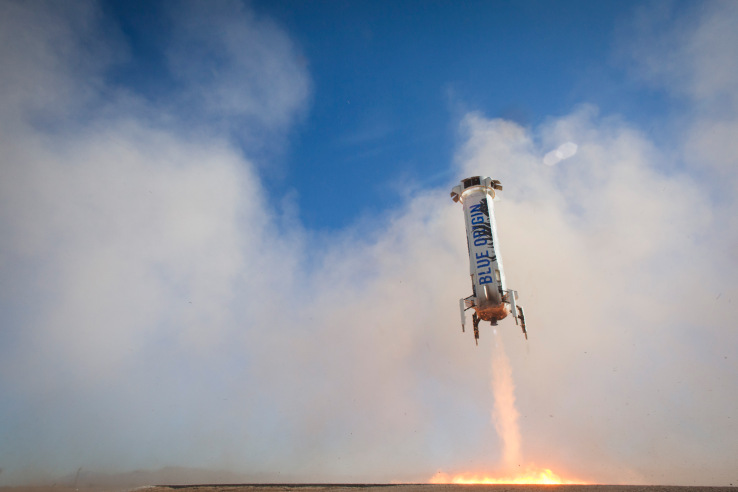Blue Origin missile successfully took off and sat down for the third time

Yesterday, the reusable ship New Shepard, tested by Amazon, made its third successful takeoff and soft landing . The capsule, in which the cosmonaut team should be located, was launched into space at an altitude of 103.8 km, and then smoothly descended to Earth by parachute. Reusable rocket made a successful vertical landing.
Flawless BE-3 restart and perfect booster landing. CC chutes
- Jeff Bezos (@JeffBezos) April 2, 2016
deployed. @BlueOrigin
')
The first successful landing of the rocket took place in November 2015. Re-launch and landing took place in January 2016 . Then the New Shepard became the first rocket, which was launched twice, both times reached the Karman line and made a soft controlled landing. Now she holds the record for triple successful start and landing.
The rocket landed at a speed of 7.7 km / h. The restart of the engines at this time was carried out at a relatively small height of about 1,200 meters. If something went wrong, the rocket would fall to the surface of the Earth in 6 seconds.
Crew Capsule is locked & ready for flt. Tortoises mark successful CC missions. #LaunchLandRepeat @BlueOrigin pic.twitter.com/akPaP9EFIu
- Jeff Bezos (@JeffBezos) April 2, 2016
So far, there were no people in the capsule, but this time she carried two sets intended for experiments in microgravity conditions provided by two universities.
The University of Central Florida set up an experiment to observe the behavior of the dusty environment, on which a ball of solid material hits:
The South-West Research Institute studied the behavior of a stony environment under microgravity conditions:
The main "competitor" from the point of view of reusable rockets, the SpaceX project, has so far succeeded only one successful landing of the carrier rocket of the Falcon 9 family. True, the New Shepard and Falcon 9 rockets have different tasks and, accordingly, a different design. The purpose of Falcon 9 is space freight, and Blue Origin wants to deal with space tourism. In addition, Falcon 9 should bring cargo into orbit, and New Shepard will make suborbital flights. Therefore, the task facing the SpaceX project is initially more difficult.
Source: https://habr.com/ru/post/392541/
All Articles